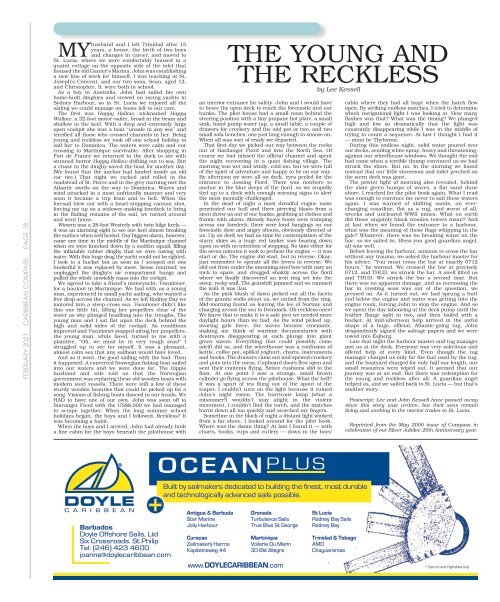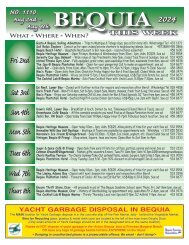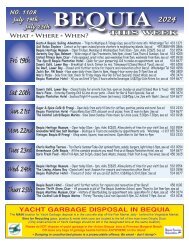Caribbean Compass Yachting Magazine - February 2021
Welcome to Caribbean Compass, the most widely-read boating publication in the Caribbean! THE MOST NEWS YOU CAN USE - feature articles on cruising destinations, regattas, environment, events...
Welcome to Caribbean Compass, the most widely-read boating publication in the Caribbean! THE MOST NEWS YOU CAN USE - feature articles on cruising destinations, regattas, environment, events...
Create successful ePaper yourself
Turn your PDF publications into a flip-book with our unique Google optimized e-Paper software.
FEBRUARY <strong>2021</strong> CARIBBEAN COMPASS PAGE 18<br />
MY<br />
husband and I left Trinidad after 15<br />
years, a house, the birth of two boys<br />
and changes in career, and moved to<br />
St. Lucia, where we were comfortably housed in a<br />
quaint cottage on the opposite side of the inlet that<br />
housed the old Ganter’s Marina. John was establishing<br />
a new line of work for himself, I was teaching at St.<br />
Joseph’s Convent, and our two sons, Sean, aged 12,<br />
and Christopher, 9, were both in school.<br />
As a boy in Australia, John had sailed his own<br />
home-built dinghies and crewed on racing yachts in<br />
Sydney Harbour, so in St. Lucia we enjoyed all the<br />
sailing we could manage on boats left to our care.<br />
The first was Happy Hollow, nicknamed Happy<br />
Wallow, a 32-foot motor-sailer, broad in the beam and<br />
shallow in the keel. With a deep and extremely large<br />
open cockpit she was a boat “unsafe in any sea” and<br />
terrified all those who crossed channels in her. Being<br />
young and reckless we took off one school holiday to<br />
sail her to Dominica. The waters were calm and our<br />
crossing to Martinique survivable. After shopping in<br />
Fort de France we returned to the dock to see with<br />
stunned horror Happy Hollow drifting out to sea. But<br />
a chase in the dinghy saved the boat for another day.<br />
(We found that the anchor had landed inside an old<br />
car tire.) That night we rocked and rolled in the<br />
roadstead of St. Pierre and in the grey morning met the<br />
Atlantic swells on the way to Dominica. Waves and<br />
wind attacked in a most unfriendly manner and very<br />
soon it became a trip from and to hell. When the<br />
foresail blew out with a heart-stopping cannon shot,<br />
forcing me up on a widower-making foredeck to bring<br />
in the flailing remains of the sail, we turned around<br />
and went home.<br />
Wimera was a 28-foot Westerly with twin bilge keels —<br />
it was an alarming sight to see one keel almost breaking<br />
the surface when well heeled. Our biggest alarm, however,<br />
came one time in the middle of the Martinique channel<br />
when we were knocked down by a sudden squall, filling<br />
the inflatable rubber dinghy that we were towing with<br />
water. With this huge drag the yacht could not be righted.<br />
I took to a bucket but as soon as I scooped out one<br />
bucketful it was replaced by more. Sense returned; we<br />
unplugged the dinghy’s air compartment bungs and<br />
pulled the whole unwieldy mass into the cockpit.<br />
We agreed to take a friend’s motoryacht, Vacationer,<br />
for a haulout in Martinique. We had with us a young<br />
man, experienced in small yacht sailing, who wanted a<br />
free drop across the channel. As we left Rodney Bay we<br />
motored into a steep cross sea. Vacationer didn’t like<br />
this one little bit, lifting her propellers clear of the<br />
water as she plunged headlong into the troughs. The<br />
young man and I sat flat upon the deck behind the<br />
high and solid sides of the cockpit. As conditions<br />
improved and Vacationer stopped airing her propellers,<br />
the young man, white faced, turned to me with a<br />
plaintive, “Oh, we must be in very rough seas!” I<br />
struggled up to see for myself. It was a pleasant,<br />
almost calm sea that any sailboat would have loved.<br />
And so it went, the good sailing with the bad. Then<br />
it happened. A converted Norwegian fishing boat sailed<br />
into our waters and we were done for. The hippie<br />
husband and wife told us that the Norwegian<br />
government was replacing these old wooden boats with<br />
modern steel vessels. There were still a few of these<br />
sturdy wooden beauties that could be picked up for a<br />
song. Visions of fishing boats danced in our heads. We<br />
HAD to have one of our own. John was soon off to<br />
Stavanger Fiord with the US$8,000 we had managed<br />
to scrape together. When the long summer school<br />
holidays began, the boys and I followed. Reckless? It<br />
was becoming a habit.<br />
When the boys and I arrived, John had already built<br />
a fine cabin for the boys beneath the pilothouse with<br />
THE YOUNG AND<br />
THE RECKLESS<br />
by Lee Kessell<br />
an interior entrance for safety. John and I would have<br />
to brave the open deck to reach the forecastle and our<br />
bunks. The pilot house had a small room behind the<br />
steering position with a tiny propane hot plate, a small<br />
sink, hand pump water tap, a small table, a couple of<br />
drawers for crockery and the odd pot or two, and two<br />
small sofa benches, one just long enough to snooze on.<br />
When all was sort of ready we departed.<br />
That first day we picked our way between the rocks<br />
out of Hardanger Fiord and into the North Sea. Of<br />
course we had missed the official channel and spent<br />
the night recovering in a quiet fishing village. The<br />
morning was wet and windy, cold too, but we were full<br />
of the spirit of adventure and happy to be on our way.<br />
By afternoon we were all on deck, eyes peeled for the<br />
entrance to Jossing Fiord. There was nowhere to<br />
anchor in the blue deeps of the fiord, so we stupidly<br />
tied up to a dock with enough warning signs to alert<br />
the most mentally challenged.<br />
In the dead of night a most dreadful engine noise<br />
penetrated our hull and three piercing blasts from a<br />
siren threw us out of our bunks, grabbing at clothes and<br />
frantic with alarm. Already heavy boots were tramping<br />
across our foredeck; there were loud bangings on our<br />
forecastle door and angry shouts, obviously directed at<br />
us. Up on deck we had no time for contemplation of the<br />
starry skies as a huge red tanker was bearing down<br />
upon us with no intention of stopping. No time either for<br />
the seven minutes it took to preheat the engine — it was<br />
start or die. The engine did start, but in reverse. Okay,<br />
just remember to operate all the levers in reverse. We<br />
slid out from under the oncoming steel bow with nary an<br />
inch to spare, and chugged shakily across the fiord<br />
where we finally discovered an iron ring set into the<br />
steep, rocky wall. The gearshift jammed and we rammed<br />
the wall. It was 3am.<br />
As the pink blush of dawn picked out all the facets<br />
of the granite walls about us, we untied from the ring.<br />
Mid-morning found us leaving the lee of Norway and<br />
charging across the sea to Denmark. Oh reckless ones!<br />
We knew that to make it to a safe port we needed more<br />
daylight hours than we had. As the wind picked up,<br />
nearing gale force, the waves became cinematic,<br />
making me think of wartime documentaries with<br />
destroyers disappearing at each plunge into giant<br />
green waves. Everything that could possibly come<br />
adrift did so, and the wheelhouse was a confusion of<br />
kettle, coffee pot, spilled yoghurt, charts, instruments<br />
and books. The drawers came out and spewed crockery<br />
and pots into the mess. Cupboard doors flew open and<br />
sent their contents flying. Settee cushions slid to the<br />
floor. At one point I saw a strange, small brown<br />
cylinder go flying across the pilothouse. What the hell?<br />
It was a spurt of tea flung out of the spout of the<br />
teapot. I couldn’t turn on the light because it ruined<br />
John’s night vision. The hurricane lamp (what a<br />
misnomer!) wouldn’t stay alight in the violent<br />
movement, I couldn’t find the torch, and the matches<br />
burnt down all too quickly and scorched my fingers.<br />
Sometime in the black of night a distant light winked<br />
from a far shore. I looked around for the pilot book.<br />
Where was the damn thing? At last I found it — with<br />
charts, books, cups and cutlery — down in the boys’<br />
cabin where they had all leapt when the hatch flew<br />
open. By striking endless matches, I tried to determine<br />
which navigational light I was looking at. How many<br />
flashes was that? What was the timing? We plunged<br />
high and low so dramatically that the light was<br />
constantly disappearing while I was in the middle of<br />
trying to count a sequence. At last I thought I had it<br />
— must be Thyboron.<br />
During this endless night, solid water poured over<br />
our decks, sending white spray, heavy and threatening,<br />
against our wheelhouse windows. We thought the end<br />
had come when a terrible thump convinced us we had<br />
struck the shore. But no. In the morning we found<br />
instead that our little storeroom and toilet perched on<br />
the stern deck was gone.<br />
The pewter light of morning also revealed, behind<br />
the slate green humps of waves, a flat sand dune<br />
shore. I reached for the pilot book again. What I read<br />
was enough to convince me never to sail these waters<br />
again. I was warned of shifting sands, an everchanging<br />
coastline, flat as a rug, and worst of all,<br />
wrecks and uncleared WWII mines. What on earth<br />
did those ungainly black wooden towers mean? And<br />
at last when we found the entrance to a harbour,<br />
what was the meaning of those flags whipping in the<br />
gale? Whatever, there was no breaking water on the<br />
bar, so we sailed in. Bless you good guardian angel,<br />
all was well.<br />
Before leaving the harbour, anxious to cross the bar<br />
without any trauma, we asked the harbour master for<br />
his advice. “You must cross the bar at exactly 0712<br />
hours,” he warned. We crossed the bar at precisely<br />
0712, and THUD, we struck the bar. A swell lifted us<br />
and THUD. We struck the bar a second time. But<br />
there was no apparent damage, and as recrossing the<br />
bar in cresting seas was out of the question, we<br />
pressed on. As it turned out, we had sprung a butt<br />
end below the engine and water was getting into the<br />
engine room, forcing John to stop the engine. And so<br />
we spent the day labouring at the deck pump until the<br />
leather flange split in two, and then bailed with a<br />
bucket. At mid-afternoon help arrived in the awful<br />
shape of a huge, official, Atlantic-going tug. John<br />
despondently signed the salvage papers and we were<br />
towed into Esjberg.<br />
Late that night the harbour master and tug manager<br />
met us at the dock. Everyone was very solicitous and<br />
offered help of every kind. Even though the tug<br />
manager charged us only for the fuel used by the tug,<br />
and the boatyard charged for only half our length, our<br />
small resources were wiped out. It seemed that our<br />
journey was at an end. But there was redemption for<br />
the young and reckless after all. A guardian angel<br />
helped us, and we sailed back to St. Lucia — but that’s<br />
another story.<br />
Postscript: Lee and John Kessell have passed away<br />
since this story was written, but their sons remain<br />
living and working in the marine trades in St. Lucia.<br />
Reprinted from the May 2000 issue of <strong>Compass</strong> in<br />
celebration of our Silver Jubilee 25th Anniversary year.<br />
Built by sailmakers dedicated to building the finest, most durable<br />
and technologically advanced sails possible.<br />
Barbados<br />
Doyle Offshore Sails, Ltd<br />
Six Crossroads. St Philip<br />
Tel: (246) 423 4600<br />
joanne@doylecaribbean.com<br />
Antigua & Barbuda<br />
Star Marine<br />
Jolly Harbour<br />
Curacao<br />
Zeilmakerij Harms<br />
Kapiteinsweg #4<br />
www.yachtshotsbvi.com<br />
Grenada<br />
Turbulence Sails<br />
True Blue St George<br />
Martinique<br />
Voilerie Du Marin<br />
30 Bld Allegre<br />
www.DOYLECARIBBEAN.com<br />
St Lucia<br />
Rodney Bay Sails<br />
Rodney Bay<br />
Trinidad & Tobago<br />
AMD<br />
Chaguaramas<br />
* Dacron and HydraNet only

















